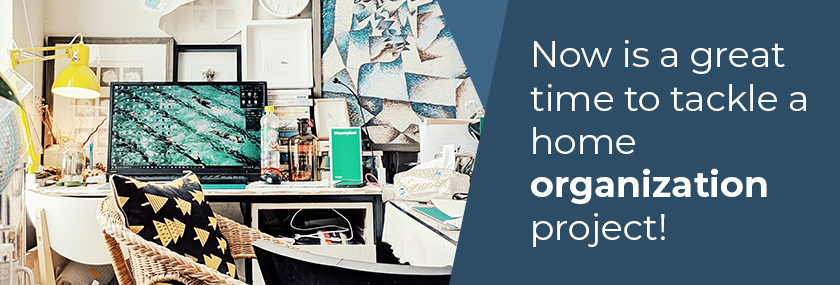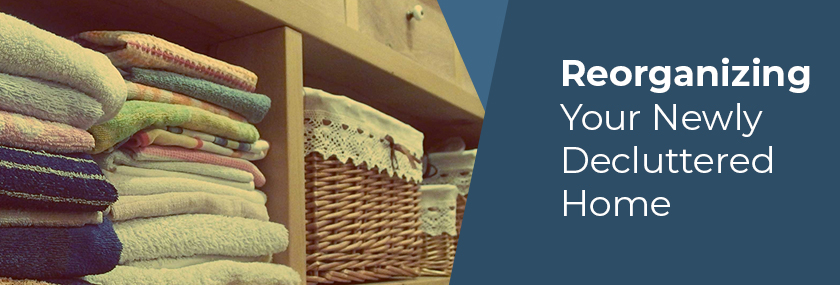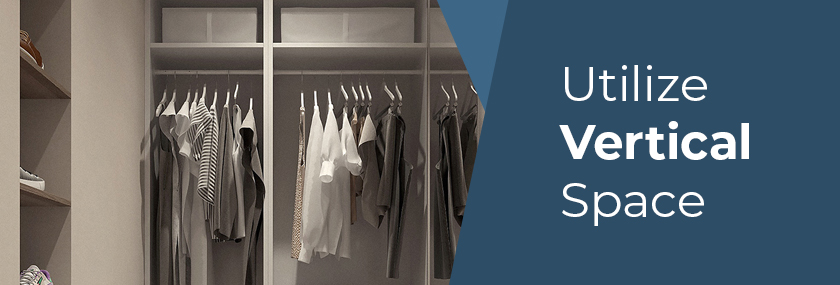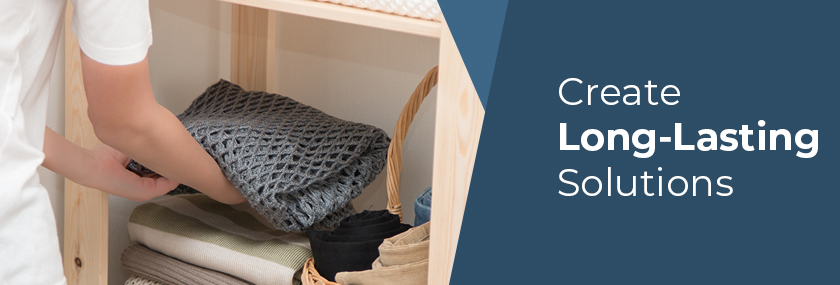The tradition of spring cleaning began in the North, where it just wasn’t possible to keep a tidy home during the long winter when months of closed windows and burning oil lamps and fires for heat left everything coated with dust and grime. Husbands and children were shooed outdoors in the warm weather, and every room would be taken apart and surfaces scrubbed multiple times, before putting things back together again, returning the home to cleanliness and order.

Today, especially here in Florida, cleaning routines are less affected by weather, but the cultural urge to clean house this time of year still exists for many. Whether your living spaces are overwhelmed with clutter or you hide it all in drawers and overflowing closets, chances are you’ve accumulated many things you don’t regularly use or need that make it hard to keep your home looking its best. Now is a great time to tackle a home organization project!
Below you’ll find a roundup of the best tips from experts on home organization to help you get started on decluttering and organizing your home, keeping the process manageable and achievable, no matter how big the job. But first, let’s take a look at the benefits of maintaining an organized and clutter-free dwelling.
Preparing for Future Moves
Even if you aren’t planning to move any time soon, you aren’t going to be in your home forever. In fact, in America we move every five years, on average. Dealing with the extra detritus you’ve collected since your last move (or brought along with you!) now, and creating orderly and well-organized living spaces will make packing and unpacking during future relocations that much more hassle-free.
Empty-nesters and others who currently have too much house for their needs should also consider what to do with their extraneous belongings should they decide to downsize.
Easing the Burden on Your Loved Ones
Whether you are just settling down to start a family or retired with grown children, it’s important to consider what will happen to your home—and everything inside—should something happen to you. Getting rid of the unwanted junk and organizing and documenting your valuable possessions now can make difficult times much easier for your children, spouse, or other loved ones, who may have to tend to the sale of your home if you are unable to do it yourself.
Letting Go of the Bad and Cherishing the Good
Sorting through and parting with unneeded possessions can also have an emotional benefit, as you revisit important times in your life, and let go of items, like objects from a previous marriage or other difficult period, that cause an emotional drain. The special items that you keep, objects that according to Marie Kondo “spark joy,” will gain importance by default, no longer lost in the background noise of a cluttered home.
Peace of Mind in the Here and Now
Perhaps the best reason for decluttering is the real-time effect on your daily life. Clutter can actually cause your body to release cortisol, a stress hormone, while living in a clean, organized, and simplified environment has shown to decrease anxiety.
Why is clutter so stressful? According to Very Well Mind, there are lots of reasons clutter can have a negative impact on our lives, from anxiety and shame about having guests over to added stress and time to find the space to do pleasurable activities in the home like crafting. As Elizabeth Scott writes, when your home is disorganized, “Each room carries visual reminders of all the work that needs to be done.”
Having a clean and organized home helps you cope with life’s ups and downs, even when there are many things going on outside your door that are beyond your control. But it’s important to create a plan of attack before starting to prevent the decluttering process from becoming more stressful than the clutter itself.
Start with Decluttering
Decluttering is easily one of the most daunting and emotionally-draining tasks in home organization, but the most efficient way to maintain a tidy home is to have less stuff to manage in the first place. Because of this, it’s always best to declutter before you try to reorganize. If you’re feeling overwhelmed by the task, consider these tips to help you through the process.
Map It Out
Before you pick any old place to start, in their “Ridiculously Thorough Guide to Decluttering Your Home,” junk removal experts Budget Dumpster recommend that you locate “clutter hotspots” and make a map of your home to start a declutter plan. Doing so will help you visualize the process, come up with the most logical plan of attack, and track your progress along the way. If a big job makes you feel overwhelmed, you can start with a smaller, manageable zone.
Don’t Do It Alone
Because possessions often take on significant meaning, it’s not a good idea to pitch things that don’t expressly belong to you. Additionally, decluttering an entire house can be a monumental task. Everyone living with you or who has items in your home should pitch in in whatever way they can.
To avoid strife, Living Tiny, Dreaming Big suggests that you let others decide which of their possessions to hold on to and what to get rid of—but feel free to guide them by asking questions to help them figure out if a given item is really essential. In order to keep people (especially children!) engaged, they say to “make it a competition to see how many bags they can fill, or plan short breaks with rewards that will motivate them.”
Even if you live alone, or most of the clutter is yours, don’t be afraid to ask for help if you need it. Organization expert Peter Walsh, writing for Oprah.com, has a fun idea to get people excited about an otherwise tedious prospect: plan a decluttering party.
Use a Sorting System
Almost every advice column on decluttering recommends that you have some kind of system for sorting through your stuff, and The Spruce suggests using boxes labeled with these four categories:
- Trash (and Recycle!): This includes any things you don’t need or want that aren’t worth donating or selling, like damaged items that aren’t worth repairing, old paperwork and art projects (sensitive papers can have their own box for shredding), and hazardous items like old toys that might contain lead or expired prescriptions.
- Give Away/Sell: As The Spruce advises, “here is your chance to be generous.” Use this box for anything that you don’t need but someone else might benefit from. Valuable items can also be set aside for sale (if you have the time and energy to do so).
- Storage: This box is for items that aren’t used regularly, but you still need at least once a year, from seasonal items (like cherished holiday decorations) to speciality tools. If you can’t imagine using it in the foreseeable future, get rid of it.
- Put Away: Because this box is reserved for things you need to access regularly, The Spruce urges you to “Monitor yourself by determining if you have a place for each item.” If you can’t find a space for the item in the common areas of your home, think about if you really need it at all.
Get Rid of Unwanted Items Right Away
Letting your unwanted items hang around in storage or take up space in your home till the “right time” to sell, donate, or dispose of defeats the purpose behind all the hard work you put into decluttering. Getting those items out of your living spaces as you go can also give you the satisfaction needed to stay motivated on large decluttering projects. For big projects, consider hiring a junk removal service or renting a dumpster. For smaller projects, there are lots of ways to get rid of your unwanted items quickly and easily.

Donate it!
Here are a few common places to donate your unwanted items:
Place: Thrift stores (like Goodwill and Salvation Army)
What: Clothing (in any condition; damaged items will be sold for recycling), working electronics, shoes and accessories, clean furniture, household items like blankets and dishes, home decor and holiday decorations, books, movies, and music, toys, and sports equipment.
How: Drop off with staff at designated locations, often located near their storefront.
Place: Habitat for Humanity ReStore
What: Working appliances, home decor, building materials, furniture, working lighting, hardware, cabinets, plumbing supplies, painting supplies.
How: Drop off at store with staff. Call to see if pickup is available.
Place: Schools (including preschools), churches, group homes, community centers, youth groups
What: Sufficient quantities of art/crafting supplies and bulk school supplies.
How: Call individual places to inquire.
Online Marketplaces and Groups
Facebook Marketplace and local Facebook groups are great places to post items for sale as well as list free items. Ashley at The Gold Hive is a major proponent of “Buy Nothing” groups, which allow you to post items for pickup without ever leaving your home. She writes, “it’s as easy as taking a photo and putting items on your porch!”
In addition to Facebook, there are lots of other places to sell or give away items including Craigslist and Offerup. Check out this extensive list from Money Peach for more options.
Recycling and Disposal
Local municipalities usually have specific guidelines available online for how to dispose of hazardous goods like paint and batteries, household goods like appliances and furniture, as well as recyclable items from magazines to used electronics. Details about Marion County’s extensive recycling and waste disposal programs can be found here.
A Word on Selling Stuff
While you might uncover some valuable items that you would like to sell, do a little research first to get an idea of their worth. Reach out to an appraiser if you think you have something really special.
For items of less value, like clothes, books, toys, or home decor, you might also consider having a yard sale. However, don’t use a future yard or garage sale as an excuse to keep all that stuff around indefinitely. In the post “Why You Should NOT Have a Garage Sale,” Nourishing Minimalism warns that “Garage sales take more work than they pay,” and that “The amount of time and energy put into having a garage sale could be spent accomplishing more: spending quality time with loved ones, or even clearing out more areas of your home.”
Also consider that tax deductions for donations at places like Habitat ReStore or the Salvation Army might prove more cost-effective. But even if it doesn’t help you much financially, consider how your donation can help others while saving you time and energy.

Reorganizing Your Newly Decluttered Home
After each “clutter hotspot” in your home has been cleared, it’s important to redesign those areas with practical organizational systems that will prevent the clutter from coming back. Here are some useful ideas and advice for reorganizing your home.
Don’t Start With a Trip to the Store
Before making a trek to the nearest box store to buy new implements for organizing, see what you already have. Look at built-in spaces or preexisting items, like closets that might just need a few shelves or hooks, bins that are now empty or half-empty after decluttering, and used jars, tins, or shoeboxes to organize smaller items.
In an article for Insider, Melissa Groff of Namastay Organized explains that it’s important to not invest in a lot of new things before you know what you really need. Instead, “Keep a list of things that might help you add some functionality later . . . using the space for a little while [first] will help narrow down the must-haves from the wants.”
Focus on High-Traffic Areas First
MarthaStewart.com advises to start with high-traffic areas like the kitchen. Not only does this help to keep disruption to your daily life to a minimum, it also maximizes your organization power by focusing it first on places where you spend the most time. Create a plan of attack which considers which spaces are used the most.
Deep Clean As You Go
Take a page from the past and deep-clean at the same time as you organize. Wipe down empty shelves and drawers, vacuum the rarely-seen bottom of your closets, and dust or wash special items you plan on keeping in storage or display, from heirloom china to cold-weather items.

Utilize Vertical Space
Getting items up and off the floor is an effective way to make rooms feel larger and tidier, and there are numerous ways to use vertical space to your advantage when organizing your home. Good Housekeeping has a useful slideshow of simple hanging storage solutions to keep counters, floors, and furniture clear while still having needed items within reach, using hooks, shelves, and hanging baskets.
Set Aside Smaller Projects
You may not be able to conquer organizing every single aspect of your home in the first go, but you can set aside future mini-organization projects in an orderly way now. For example, DO make a box of loose photos to organize on a rainy day, then set reminders on your calendar to actually do this. DON’T put every unfinished sewing project in a bin and assume you’ll get to it one day (see information above for donating crafting supplies!).

Create Long-Lasting Solutions
All of your hard work can easily be undone in a short time if your newly organized spaces aren’t practical or you continue to follow the habits that caused your home to get over-cluttered to begin with. Here are a few final pieces of advice to help you stay on track and keep your home tidy and clutter-free.
- Leave room to grow. Make sure each new storage area is not already at capacity.
- Set guidelines. Create rules for bringing new items in the home. For example, for every new toy or item of clothing, an old one must be donated.
- Stop accumulating clutter. Start new holiday traditions to avoid accumulating items, like Secret Santa gift exchanges to reduce gift giving or give experiences. Think of other places (like your favorite store) that encourage you to buy things you don’t need, and create a plan for how to avoid past behaviors.
- Get social. Scheduling regular get-togethers in your home, even just an informal chat over tea, will encourage you to keep your house “guest ready.”
- Keep decluttering. Keep a box for donate/sell items in an easy-to-access location, adding to it regularly.
- Let your system evolve. If a certain place is still getting cluttered, or a current organization spot isn’t really working for you, think about ways to change it up.
The old saying “A clean home is a happy home” is as applicable today as ever. While decluttering and home organization have become hot topics recently, our ancestors have always used this time of year for turning out their homes, tidying up, and starting anew. Perhaps the best bit of advice for keeping an organized domestic space is to plan for regularly-scheduled purges and cleanings that allow you to stay organized before things get out of control. Why not start a new tradition today?